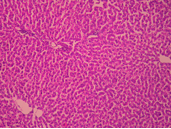
Chemoprotective and Antioxidant Activities of Methanolic Extract of Amaranthus Spinosus Leaves on Paracetamol Induced Liver Damage in Rats
Abstract
Objective: Amaranthus spinosus Linn. (Amaranthaceae), the leaves were boiled without salt and consumed for 2−3 days to cure jaundice used by tribal of Kerala (India). Methanol extract of whole plant of A. spinosus Linn, (MEAS) was screened for hepatoprotective potency against paracetamol (PCM) (3 gm/kg. o.p.) induced-liver damage in Wistar rats at dose of 200 and 400 mg/kg respectively. Materials and methods: A. spinosus was collected from surroundings of chickballapur, Karnataka (India). Whole plant was extracted with methanol. Hepatoprotective activity of MEAS was evaluated in PCM induced hepatotoxicity in Wistar rats by measuring liver marker serum enzymatic levels of serum glutamate oxaloacetate transaminase (AST), serum glutamate pyruvate transaminase (ALT), albumin (ALB), total protein (TP), total bilirubin, direct bilirubin levels and the markers for oxidative defense namely malondialdehyde (MDA), reduced glutathione (GSH), catalase (CAT) and total thiols (TT). Histopathological studies of liver were done to assess the cellular damage. Results: The results of our study showed significant (P<0.001) protection against PCM induced hepatic damage in experimental animals following the administration of MEAS. Our results were compared with silymarin (100 mg/kg), a known hepatoprotective drug. Conclusions: This presence of amino acids, flavonoids and phenolic compounds in the MEAS might be responsible for its marked chemoprotective and antioxidant activities in paracetamol induced-liver damage in Wistar rats.
Keywords
Amaranthus spinosus leaves; chemoprotective; paracetamol; antioxidant activity
DOI: 10.5457/ams.v39i2.159
